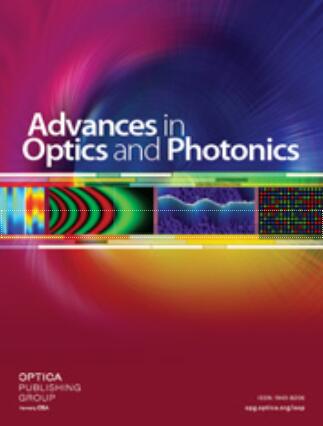光偏振中的量子概念
IF 23.8
1区 物理与天体物理
Q1 OPTICS
引用次数: 35
摘要
我们全面回顾了光偏振特性的量子理论。在经典光学中,这些特征是由斯托克斯参数表征的,它可以用庞加莱球进行几何解释。值得注意的是,这些斯托克斯参数也可以应用于量子世界,但随后出现了重要的差异:现在,由于光子数量的波动是不可避免的,人们被迫在三维庞加莱空间中工作,而庞加莱空间可以被视为一组嵌套的球体。此外,斯托克斯变量的高阶矩可能对量子态起着重要作用,这对大多数经典高斯态来说都不是这样。这带来了这两个世界之间的重要区别,我们将详细讨论。特别是,经典的极化度在量子领域产生了令人不满意的结果。我们比较了不同的量子度,提出它们对不同态的排序是不同的。最后,探讨了本质非经典态,并讨论了它们在量子技术中的潜在应用。本文章由计算机程序翻译,如有差异,请以英文原文为准。
Quantum concepts in optical polarization
We comprehensively review the quantum theory of the polarization properties of light. In classical optics, these traits are characterized by the Stokes parameters, which can be geometrically interpreted using the Poincare sphere. Remarkably, these Stokes parameters can also be applied to the quantum world, but then important differences emerge: now, because fluctuations in the number of photons are unavoidable, one is forced to work in the three-dimensional Poincare space that can be regarded as a set of nested spheres. Additionally, higher-order moments of the Stokes variables might play a substantial role for quantum states, which is not the case for most classical Gaussian states. This brings about important differences between these two worlds that we review in detail. In particular, the classical degree of polarization produces unsatisfactory results in the quantum domain. We compare alternative quantum degrees and put forth that they order various states differently. Finally, intrinsically nonclassical states are explored and their potential applications in quantum technologies are discussed.
求助全文
通过发布文献求助,成功后即可免费获取论文全文。
去求助
来源期刊

Advances in Optics and Photonics
OPTICS-
CiteScore
56.60
自引率
0.00%
发文量
13
期刊介绍:
Advances in Optics and Photonics (AOP) is an all-electronic journal that publishes comprehensive review articles and multimedia tutorials. It is suitable for students, researchers, faculty, business professionals, and engineers interested in optics and photonics. The content of the journal covers advancements in these fields, ranging from fundamental science to engineering applications.
The journal aims to capture the most significant developments in optics and photonics. It achieves this through long review articles and comprehensive tutorials written by prominent and respected authors who are at the forefront of their fields.
The journal goes beyond traditional text-based articles by enhancing the content with multimedia elements, such as animation and video. This multimedia approach helps to enhance the understanding and visualization of complex concepts.
AOP offers dedicated article preparation and peer-review support to assist authors throughout the publication process. This support ensures that the articles meet the journal's standards and are well-received by readers.
Additionally, AOP welcomes comments on published review articles, encouraging further discussions and insights from the scientific community.
In summary, Advances in Optics and Photonics is a comprehensive journal that provides authoritative and accessible content on advancements in optics and photonics. With its diverse range of articles, multimedia enhancements, and dedicated support, AOP serves as a valuable resource for professionals and researchers in these fields.
 求助内容:
求助内容: 应助结果提醒方式:
应助结果提醒方式:


